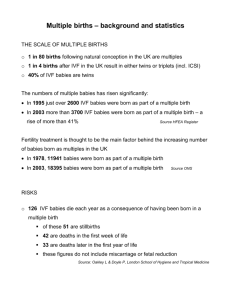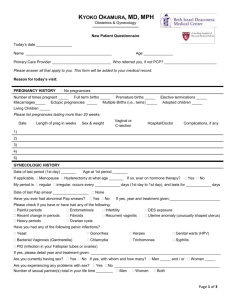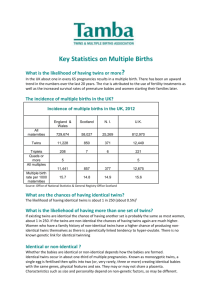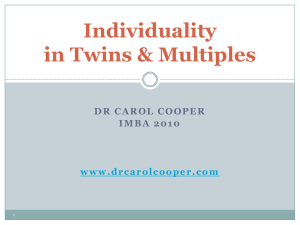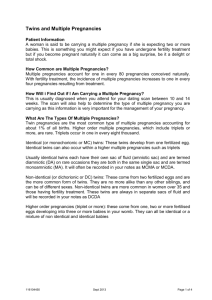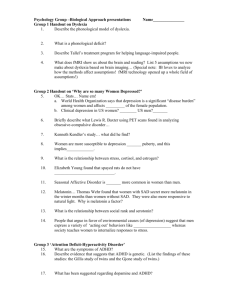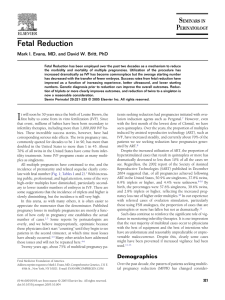How Do Iatrogenic Multiple Pregnancies Complicate
advertisement
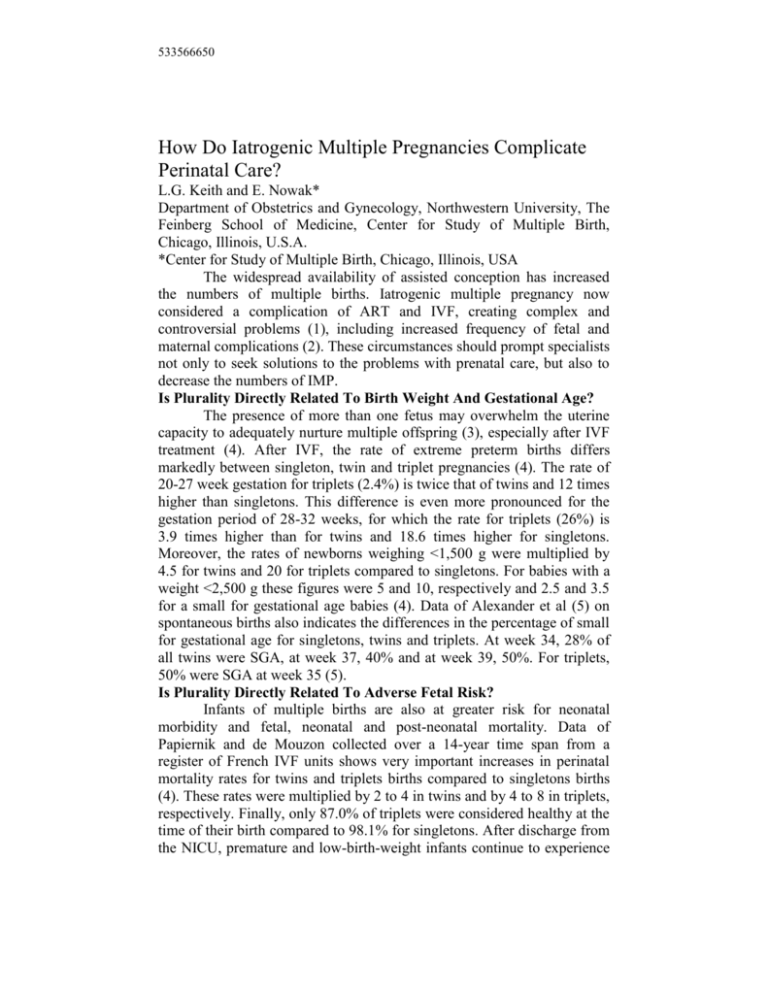
533566650 How Do Iatrogenic Multiple Pregnancies Complicate Perinatal Care? L.G. Keith and E. Nowak* Department of Obstetrics and Gynecology, Northwestern University, The Feinberg School of Medicine, Center for Study of Multiple Birth, Chicago, Illinois, U.S.A. *Center for Study of Multiple Birth, Chicago, Illinois, USA The widespread availability of assisted conception has increased the numbers of multiple births. Iatrogenic multiple pregnancy now considered a complication of ART and IVF, creating complex and controversial problems (1), including increased frequency of fetal and maternal complications (2). These circumstances should prompt specialists not only to seek solutions to the problems with prenatal care, but also to decrease the numbers of IMP. Is Plurality Directly Related To Birth Weight And Gestational Age? The presence of more than one fetus may overwhelm the uterine capacity to adequately nurture multiple offspring (3), especially after IVF treatment (4). After IVF, the rate of extreme preterm births differs markedly between singleton, twin and triplet pregnancies (4). The rate of 20-27 week gestation for triplets (2.4%) is twice that of twins and 12 times higher than singletons. This difference is even more pronounced for the gestation period of 28-32 weeks, for which the rate for triplets (26%) is 3.9 times higher than for twins and 18.6 times higher for singletons. Moreover, the rates of newborns weighing <1,500 g were multiplied by 4.5 for twins and 20 for triplets compared to singletons. For babies with a weight <2,500 g these figures were 5 and 10, respectively and 2.5 and 3.5 for a small for gestational age babies (4). Data of Alexander et al (5) on spontaneous births also indicates the differences in the percentage of small for gestational age for singletons, twins and triplets. At week 34, 28% of all twins were SGA, at week 37, 40% and at week 39, 50%. For triplets, 50% were SGA at week 35 (5). Is Plurality Directly Related To Adverse Fetal Risk? Infants of multiple births are also at greater risk for neonatal morbidity and fetal, neonatal and post-neonatal mortality. Data of Papiernik and de Mouzon collected over a 14-year time span from a register of French IVF units shows very important increases in perinatal mortality rates for twins and triplets births compared to singletons births (4). These rates were multiplied by 2 to 4 in twins and by 4 to 8 in triplets, respectively. Finally, only 87.0% of triplets were considered healthy at the time of their birth compared to 98.1% for singletons. After discharge from the NICU, premature and low-birth-weight infants continue to experience high rates of morbidity. Such infants are likely to require more intensive outpatient service and recurrent hospitalizations and are at risk for longterm handicap and disabilities (6). Is Plurality Directly Related To Adverse Maternal Outcome? Multiple pregnancy is accompanied by very serious implications for the mother in terms of hypertensive disorders, eclampsia, complications of treatment for premature contractions and prolonged bed rest, as well as operative delivery. Any of these conditions may precede maternal mortality. However, because multiple pregnancies are generally not registered as the cause of death, accurate mortality figures are unknown (3). Significant increases are seen in the frequency of maternal complications in iatrogenic compared to spontaneously conceived multiples. Nyirati et al (7) analyzed the outcomes of 232 spontaneous multiple compared to 98 induced twins and 16 induced triplets. Pregnancy induced hypertension was higher among induced twins compared to spontaneous twins and the incidence of pre-eclampsia was higher among induced triplets compared to spontaneous triplets. Is There Evidence That Mothers >40 Who Have Iatrogenic Multiplies Constitute A New Obstetric Entity? Infertile couples undergoing ART often tend to be older and are desperate to achieve a clinical pregnancy. Older maternal age, which is associated with a poor ovarian response and limited oocyte reserve become a challenge for the ART specialist. Luke (8) observed that the birth rate has been relatively stable during the past 20 years for women in their twenties and it’s rising for women in their thirties and forties. The proportion of multiple births is much higher among older mothers and this percentage has risen dramatically since 1975. In 1998, the number of multiple births to mothers 45-year old was ten time higher than that among women in their thirties. The above-mentioned trends are directly related to assisted reproductive technologies, as well as the choices made by treating physicians. References (1) KEITH L, OLESZCZUK JJ, Iatrogenic multiple birth, multiple pregnancy and assisted reproductive technologies, Int J Gynecol Obstet, 64:11-25, 1999. (2) NEWMAN RB, Obstetrical complications unique to multiple gestations, in Newman RB, Luke B (eds), Multifetal Pregnancies, Philadelphia PA, Lippincott Williams & Wilkins Softbound, 2000, pp 149-72. (3) BLICKSTEIN I, KEITH L, The epidemic of multiple pregnancies, Postgraduate Obstet Gynecol, 21:1-6, 2001. 2 (4) PAPIERNIK E, DE MOUZON J, Perinatal results from triplet pregnancies and births from the register of French IVF centers: 1986-98, in Keith L, Blickstein I (eds), Triplet Pregnancies and Their Consequences, London, Parthenon Publishing Group, 2003. (5) ALEXANDER G, KOGAN M, MARTIN J, What are the fetal growth patterns of singletons, twins and triplets in the USA, Clin Obstet Gynecol. 41:115-25, 1998. (6) LUKE B, KEITH LG, The contribution of singletons, twins and triplets to low birth weight, infant mortality and handicap in the United States, J Reprod Med, 37:661-66, 1992. (7) NYIRATI I, OUROS H, BARTFAI G, ET AL, Iatrogenic multiple pregnancy: Higher risk than a spontaneous one? J Reprod Med, 42:695-98, 1997. (8) LUKE B, Perinatal significance of multiple gestation, in Newman R, Luke B (eds), Multifetal Pregnancy, Philadelphia PA, Lippincott Williams & Wilkins Softbound, 2000, pp 1-14. 3
